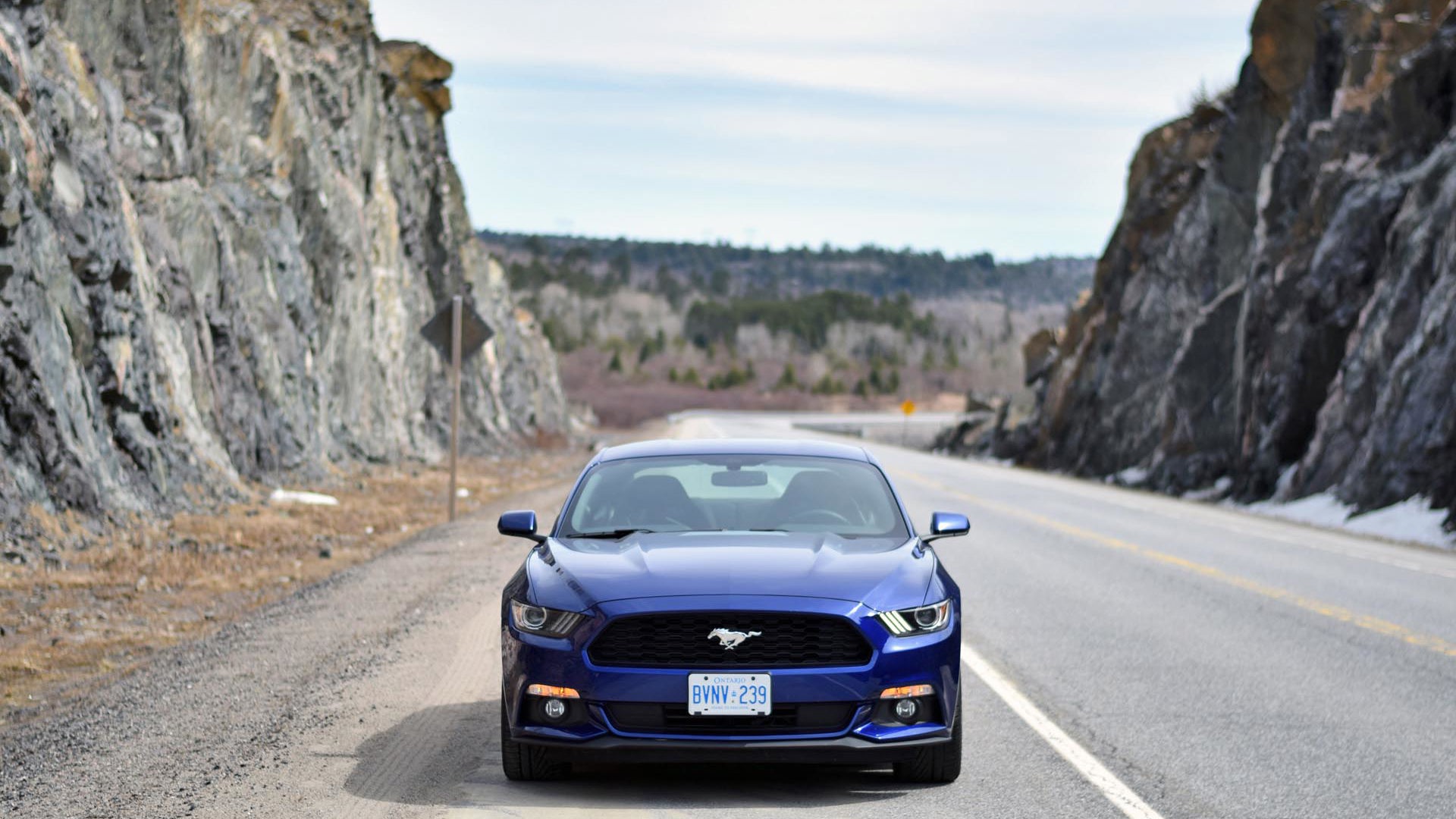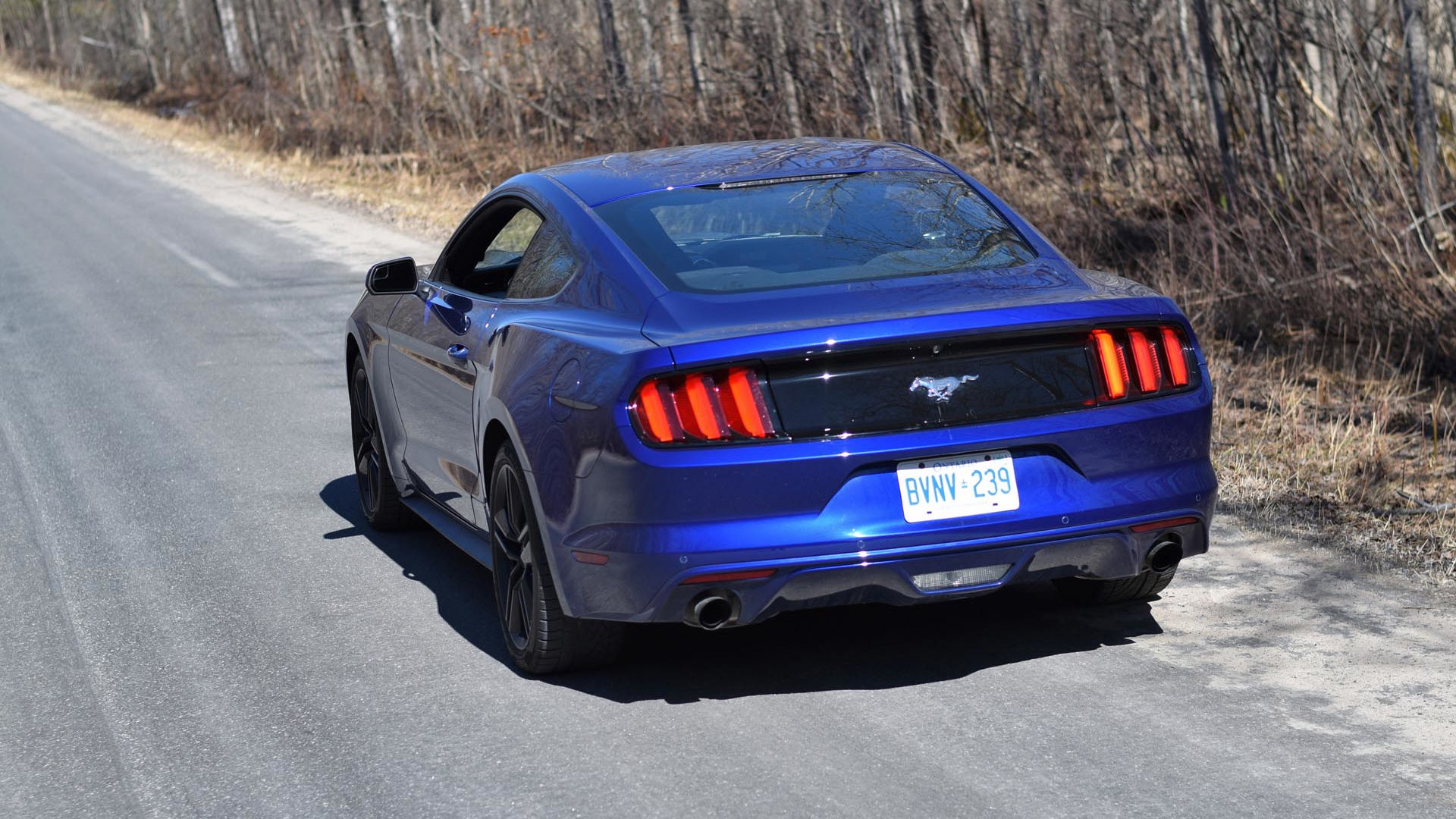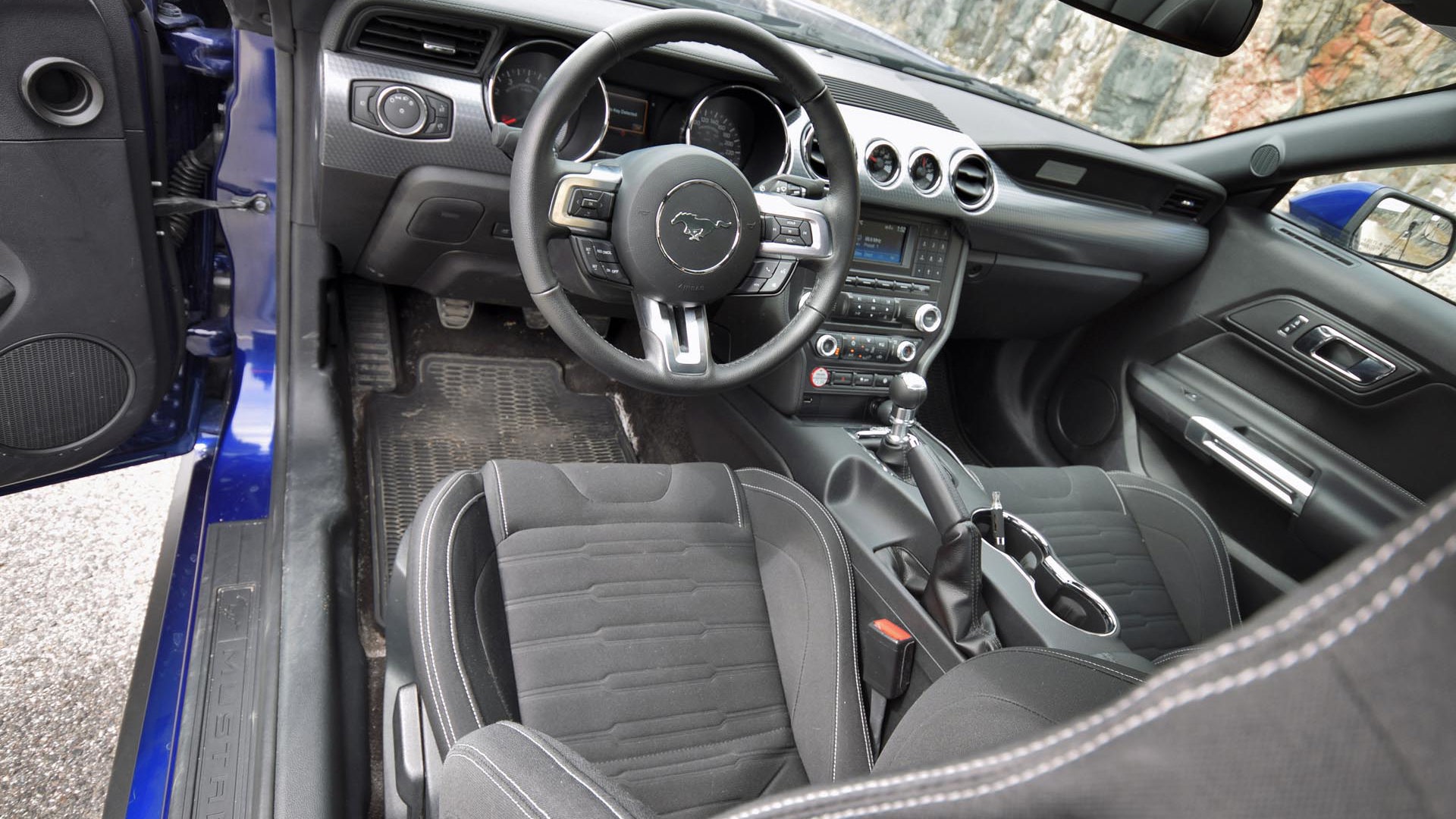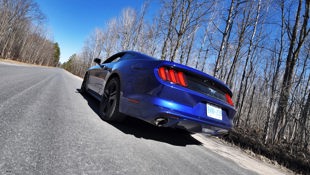 AutoTrader SCORE
AutoTrader SCORE
-
EXTERIOR STYLING8/10
-
INTERIOR8/10
-
PERFORMANCE8/10
-
COMFORT8/10
-
FUEL ECONOMY10/10
You know how you imagined the Scion FR-S / Subaru BR-Z being pretty awesome with about 100 more horsepower? Or how you figured the Challenger or Camaro would be pretty slick if things were smaller, lighter, and tighter in the controls? Or how you figured the Genesis Coupe would be pretty swell with a more refined interior and even sharper reflexes? Well, wish not, fellow gear-heads: the answer to your wishes is here, and it’s called the 2015 Ford Mustang EcoBoost.
Instant. Instant, instant, instant. It’s the word to describe the controls.
For its latest iteration, Mustang engineers launched an all-out assault on slack, slop and softness. The resulting car is lower, wider, stiffer and stronger than ever, and it launches a new era for Mustang handling and responsiveness. The new Mustang is very serious, and it no longer rides and handles like undercooked lasagna.
One of the most important parts of driving a sports car is the way it feels, and the way that makes you, the driver, feel. Forget looks, driving environment and flashy features for a moment: at its core, driving a sports car is all about experiencing a feeling. If you agree, the latest Ford Mustang is a car that should be given your immediate attention.
Instant. Instant, instant, instant. It’s the word to describe the controls.
Steering has zero slack. Not a little hint of slack, or a whiff of slack, but actually, zero slack. Even a little twitch on the wheel sends it darting around. You don’t even need to use your arms to steer—just tighten up the muscles on one side of your hand, or the other, and the car heads that way. Last time I drove something with steering this sharp and fast and instantaneous, it was a $165,000 Porsche 911 GT3. So ya, it’s pretty fricken good.
For customization of Mustang’s steering, drivers can tap a button to pick from different modes. Normal works well as an all-purpose setting, the sport setting is the quick and sharp one, possibly even bordering on too quick and sharp for around-town use, which is sweet. If you’re cruising the highway while blasting AC/DC and enjoying an inconveniently-drippy burrito, use the comfort mode instead. It’s more laid back. In any case, and especially with the sport calibration engaged, drivers can expect an instant read of what’s happening between the tires and the pavement during hard driving, and lightning reflexes.
Those are backed up fully by the new suspension. The body is kept sprung tautly over the wheels, and the tester nearly felt like a sports compact riding a set of aggressive aftermarket coilovers. All body roll occurs the instant the steering input is dialed in, then, Mustang takes a set, and all further steering inputs are transmitted precisely to the road, rather than being used to squash the springs. The result, from the driver’s seat, is a tuned feeling, and high level of ‘right now’ obedience. As hard as you’d drive this thing on a public road, there’s less understeer or oversteer, and more of a whole wack of grip.
The ride can get shamelessly busy and bouncy-jouncy on rough surfaces, though ride quality isn’t easily disturbed, rough and jarring sensations are largely kept out of the cabin, and the suspension and wheels never feel or sound like they’re getting kicked around like a bad-guy in a Segal flick. Further, the heavy and locked-in steering and newly-independent rear suspension keep Mustang from bounding and skipping over bumps. It handles real-life roads real nice, and there’s a higher-than-average level of feeling connected and locked on here, even when that road is a nasty one.
There’s instant brake pedal response too, with the standard, massive four-wheel discs biting hard and fast from the slightest touch of the pedal. Pals at the local cruise night asked how much the tester’s brake upgrade was after looking at the gigantic calipers, and seemed surprised that they were, in fact, standard.
Even the shifter and clutch feel dialed-in. The shifter is heavy, precise, and clicks into its gear with a solid, thick shift action calibrated carefully against the heavy, solid and hard-biting clutch. This makes it easy to shift smooth and fast, and there’s no soccer-mom marshmallow pedal here, which is sweet. You could get an automatic transmission in your Mustang if your back sucks and your wife has to drive it, but then your pals would have a gathering to mourn the death of your manhood, so you’d probably just better get the stick.
In all, Mustang is now dynamically better set up than ever for shenanigans, hooliganism and even nincompoopery. It’s really, really good.
Power came from a 2.3L four-cylinder EcoBoost engine, feeding an intercooled turbocharger through a pulse-isolating exhaust manifold for fast spool-up of 310 horsepower and even more torque. This little beastie smashes the output of the literally twice-as-big V8 engines used in Mustangs not very long ago, all while contributing to that light and playful front end, and steering.
It goes like the wind, delivers a thick slab of torque from just off of idle, and makes delightful turbocharger noises at the slightest touch of the throttle, which you can enjoy if you’ve got the windows down and your ears open. Prodded, this powerplant pulls with ferocity almost right to redline, presses torsos generously into seatbacks, and repeats the process through each gear until drivers lift. Driven gently, it’s quiet, smooth, and works with a pleasing level of effortlessness. This is absolutely not an eco-tuned performance slouch of a powerplant: it’s a serious piece.
Second Opinion: Test Drive: 2015 Ford Mustang EcoBoost
It also turned in awesome mileage. After about 1,800 km of driving, I managed 9.3 L/100 km, measured by hand. The computer made it 9 L/100 km, dead on. And that’s with 400 km of excessively windy highway driving, and rolling on winter tires during my early spring test. Cars with 310 horsepower don’t get much thriftier.
But this engine is both the best, and worst, thing about the new Mustang.
Here’s the thing: if you’re a car nut, you probably want your Mustang to make a noise that sends nearby children running to hide in a closet under their security blanket. The tester didn’t achieve that goal, instead treating drivers only to a dull and boring hum when opened up. It’s not a good noise, or a bad noise, it’s just a noise. Further, with maximum torque arriving at very low revs and a relatively flat power curve, there’s only a hint of that peaky, rising action to the acceleration at full throttle. The power is all there, it’s just not delivered with any particular excitement.
Budget for an aftermarket exhaust to taste, but not a stupid-loud one, as that makes you a pesky ricer. Of course, opting for Mustang’s available Coyote 5.0L V8 would solve the sound-effects problems, too.
Ultimately, here’s a car that feels incredibly dialed-in, honed, sharp, and makes a currently available Camaro or Challenger feel a little like a bus.
Drivers take it all in from an interior that has been stepped up considerably—with a broader selection of premium materials, more contrasting color and texture, and more detailed elements for a layer of sophistication. At-hand storage implements are adequate, the cupholders are proper and no longer interfere with shifter operation, and the dash-mounted boost gauge and digital gauge pod in the instrument cluster are welcomed touches. This cabin is now where it needs to be in terms of looks and feel and quality.
Typical Mustang complaints inside: rear seats are best used by non-adults, and front-seat occupants may wish for a snudge more room around them. At 5’10 and 220 lbs, your writer found Mustang to be comfy-snug and sporty, not tight or claustrophobic.
Consider the Mustang EcoBoost a priority test drive if you’re after great mileage from something that feels smaller, trimmer, and lighter on its feet than a comparable Challenger or Camaro, or something that’s frisky and taut, like an FR-S or BR-Z, but with that extra hundred or so horsepower and a more potent braking system. Thanks to the heavy focus on a finely-engineered feel, this might be the first mid-level Mustang anyone’s ever bought to access a really, really good drivers car for their money.
| Warranty: 3 years/60,000 km; 5 years/100,000 km powertrain; 5 years/unlimited distance corrosion perforation; 5 years/100,000 km roadside assistance Competitors: |
| Model Tested | 2015 Ford Mustang EcoBoost Coupe |
|---|---|
| Base Price | $27,999 |
| A/C Tax | $100 |
| Destination Fee | $1,600 |
| Price as Tested | $35,399 |
|
Optional Equipment
Floor Mats ($150), Security Package ($700), EcoBoost Performance Package ($3,000), Park Assist ($350), Recaro Seats ($1,500)
|
|































